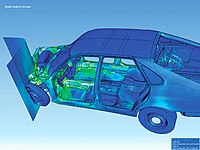
Photo from wikipedia
Digital elevation model (DEM) generated by bistatic synthetic aperture radar interferometry (InSAR) usually has systematic plane and elevation errors. However, the DEM adjustment method based on the function model can… Click to show full abstract
Digital elevation model (DEM) generated by bistatic synthetic aperture radar interferometry (InSAR) usually has systematic plane and elevation errors. However, the DEM adjustment method based on the function model can only correct systematic elevation error, affecting the plane accuracy of DEM mosaic products. Given this issue, this article proposes a 3-D InSAR-DEM block adjustment method based on general models with a separate adjustment strategy, that is, first correct vertical error using the adjustment method based on the function model and then correct horizontal error using the method based on rational function model after compensating for elevation errors. In order to extract the tie points (TPs) and ground control points (GCPs) used in adjustment, we propose a normalized correlation coefficient matching method based on complex slope maps (NCC-CSM). We conduct experiments using 29 TanDEM-X coregistered single look slant range complex data. The accuracies of adjustment results are verified using ICESat-2 ATL08 data and selected GCPs, respectively. The adjustment experiments show that the elevation accuracy of InSAR-DEM is improved from 1.70 to 1.35 m, the absolute and relative plane accuracies are improved by 5.58 and 11.53 m, respectively, and the horizontal and vertical geometric discontinuity in the overlapping area disappear. The matching experiments of TPs and GCPs show that the proposed NCC-CSM method is superior to the traditional NCC method based on DEM (NCC-DEM), especially in flat areas.
Journal Title: IEEE Journal of Selected Topics in Applied Earth Observations and Remote Sensing
Year Published: 2023
Link to full text (if available)
Share on Social Media: Sign Up to like & get
recommendations!